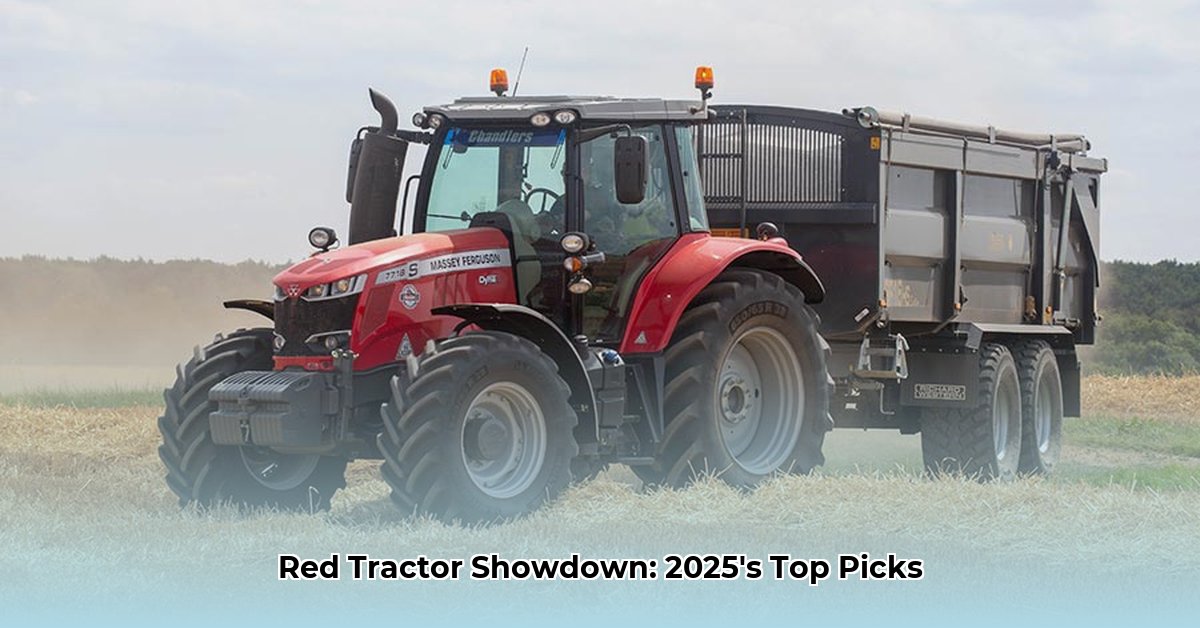
Investing in a tractor is a significant decision for any farmer. It's a long-term commitment directly impacting farm productivity and profitability. This comprehensive guide helps you navigate the diverse world of red tractors in 2025, focusing on key factors to make an informed purchase. From comparing leading brands to securing the best financing and dealer support, we'll equip you to choose the perfect tractor for your operation. For budget-conscious farmers, check out this guide on [affordable tractor brands](https://most-affordable-tractor-brand.pages.dev).
Understanding the Red Tractor Market Landscape
The market for red tractors is surprisingly diverse. Global giants like Mahindra compete with established players such as Case IH and Massey Ferguson, each with unique strengths and geographic focuses. Technological advancements further differentiate these brands. Emission standards, automation levels (from basic controls to advanced GPS guidance), and horsepower ranges vary considerably, impacting both operational efficiency and environmental impact. Regional preferences also influence market share, with Mahindra, for example, enjoying significant popularity in developing nations, while Case IH and Massey Ferguson hold stronger positions in North America and Europe. This highlights the importance of considering your specific needs and regional context when choosing a tractor. Isn't understanding these market nuances crucial for maximizing your return on investment?
Choosing Your Red Tractor: Key Factors to Consider
Before comparing specific brands, assess your farm's unique requirements. This involves careful consideration of several key factors:
Budget: How much can you realistically afford, factoring in financing options and potential ongoing maintenance costs?
Farm Size and Terrain: A small-scale farm may suit a compact tractor, while a large operation demands a higher horsepower model designed for diverse terrains.
Required Horsepower: The horsepower needed depends on the tasks your tractor will perform (e.g., planting, tilling, harvesting). Overestimating or underestimating horsepower can significantly impact efficiency and operational costs.
Technological Needs: Do you need advanced features like GPS guidance, automatic steering, or other automation systems? These technologies can enhance precision and efficiency but also increase the initial investment.
Fuel Efficiency and Maintenance: Fuel costs and maintenance expenses are ongoing factors influencing your total cost of ownership. Prioritize fuel-efficient models and consider brands with readily available parts and reliable dealer networks. Are you considering the long-term maintenance costs alongside the initial purchase price?
Comparing Top Red Tractor Brands
The following table offers a simplified comparison of leading red tractor brands. Remember, this is a general overview; specific model specifications should be reviewed individually for detailed analysis.
| Brand | Strengths | Potential Weaknesses | Typical Horsepower Range | Geographic Strengths |
|---|---|---|---|---|
| Mahindra | Affordable, large market share, global reach | Technology might be less advanced in some models | Wide range | Developing Countries |
| Case IH | Powerful models, advanced technology | Can be pricier | High | North America, Europe |
| Massey Ferguson | Reliable, diverse models | May not have the latest tech in all models | Wide range | Europe, North America |
| Branson | Compact tractors, good value for money | More limited horsepower options | Low to medium | North America |
(This table represents a simplified comparison. Actual strengths and weaknesses may vary significantly by model. Always consult the manufacturer’s specifications.)
Navigating Financing and Dealer Support
Securing financing is a crucial aspect of the tractor purchasing process. Many dealerships offer financing plans, comparable to car loans. Banks and credit unions also provide agricultural loans, each with diverse interest rates and repayment terms. Exploring various options is essential to securing the most favorable terms. Leasing may also be an option, depending on long-term farm plans and financial strategies.
Selecting a reliable local dealer is equally critical. A strong dealer relationship ensures timely maintenance, rapid access to parts, and prompt repairs minimizing costly downtime. Thorough research, including online reviews and recommendations from fellow farmers, is vital in identifying a dependable dealer who will be a true partner in your farm's success. This partnership extends beyond the initial purchase, ensuring the long-term productivity and reliability of your tractor. Isn’t a proactive approach to dealer selection critical for maximizing uptime and minimizing repair costs?
A Step-by-Step Guide to Choosing Your Tractor
Assess your farm's specific needs: This includes land size, terrain, crop types, budget, and desired level of automation.
Research tractor brands and models: Compare horsepower, emission standards, technology features, and fuel efficiency.
Compare financing options: Explore dealership financing, bank loans, credit union loans, and leasing arrangements to find the best financial terms.
Identify and evaluate local dealers: Check online reviews, seek recommendations, and assess their service capabilities and parts availability.
Test drive tractors (if possible): Experience the tractor's operation and comfort first-hand before committing to a purchase.
Make your informed decision: Select the tractor that best aligns with your farm’s needs, budget, and long-term goals.
Conclusion
Choosing the right red tractor is a multifaceted decision that requires careful planning and research. By thoroughly considering your farm's specific needs, evaluating leading brands, securing appropriate financing, and establishing a strong relationship with a reliable dealer, you pave the way for a successful and profitable farming operation. Remember, the right tractor is an invaluable investment in your farm's future.